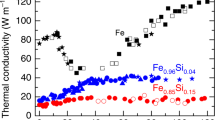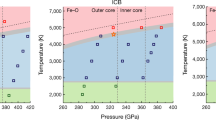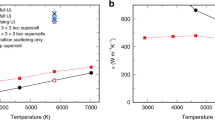Abstract
Earth continuously generates a dipole magnetic field in its convecting liquid outer core by a self-sustained dynamo action. Metallic iron is a dominant component of the outer core, so its electrical and thermal conductivity controls the dynamics and thermal evolution of Earth’s core1. However, in spite of extensive research, the transport properties of iron under core conditions are still controversial2,3,4,5,6,7,8,9. Since free electrons are a primary carrier of both electric current and heat, the electron scattering mechanism in iron under high pressure and temperature holds the key to understanding the transport properties of planetary cores. Here we measure the electrical resistivity (the reciprocal of electrical conductivity) of iron at the high temperatures (up to 4,500 kelvin) and pressures (megabars) of Earth’s core in a laser-heated diamond-anvil cell. The value measured for the resistivity of iron is even lower than the value extrapolated from high-pressure, low-temperature data using the Bloch–Grüneisen law, which considers only the electron–phonon scattering. This shows that the iron resistivity is strongly suppressed by the resistivity saturation effect at high temperatures. The low electrical resistivity of iron indicates the high thermal conductivity of Earth’s core, suggesting rapid core cooling and a young inner core less than 0.7 billion years old10. Therefore, an abrupt increase in palaeomagnetic field intensity around 1.3 billion years ago11 may not be related to the birth of the inner core.
This is a preview of subscription content, access via your institution
Access options
Subscribe to this journal
Receive 51 print issues and online access
$199.00 per year
only $3.90 per issue
Buy this article
- Purchase on Springer Link
- Instant access to full article PDF
Prices may be subject to local taxes which are calculated during checkout



Similar content being viewed by others
References
Hirose, K., Labrosse, S. & Hernlund, J. Composition and state of the core. Annu. Rev. Earth Planet. Sci. 41, 657–691 (2013)
Stacey, F. & Anderson, O. Electrical and thermal conductivities of Fe-Ni-Si alloy under core conditions. Phys. Earth Planet. Inter. 124, 153–162 (2001)
Stacey, F. & Loper, D. A revised estimate of the conductivity of iron alloy at high pressure and implications for the core energy balance. Phys. Earth Planet. Inter. 161, 13–18 (2007)
Sha, X. & Cohen, R. E. First-principles studies of electrical resistivity of iron under pressure. J. Phys. Condens. Matter 23, 075401 (2011)
de Koker, N., Steinle-Neumann, G. & Vlcek, V. Electrical resistivity and thermal conductivity of liquid Fe alloys at high P and T, and heat flux in Earth's core. Proc. Natl Acad. Sci. USA 109, 4070–4073 (2012)
Pozzo, M., Davies, C., Gubbins, D. & Alfè, D. Thermal and electrical conductivity of iron at Earth's core conditions. Nature 485, 355–358 (2012)
Gomi, H. et al. The high conductivity of iron and thermal evolution of the Earth's core. Phys. Earth Planet. Inter. 224, 88–103 (2013)
Seagle, C., Cottrell, E., Fei, Y., Hummer, D. & Prakapenka, V. Electrical and thermal transport properties of iron and iron–silicon alloy at high pressure. Geophys. Res. Lett. 40, 5377–5381 (2013)
Gomi, H. & Hirose, K. Electrical resistivity and thermal conductivity of hcp Fe–Ni alloys under high pressure: implications for thermal convection in the Earth's core. Phys. Earth Planet. Inter. 247, 2–10 (2015)
Labrosse, S. Thermal evolution of the core with a high thermal conductivity. Phys. Earth Planet. Inter. 247, 36–55 (2015)
Biggin, A. et al. Palaeomagnetic field intensity variations suggest Mesoproterozoic inner-core nucleation. Nature 526, 245–248 (2015)
Bridgman, P. W. The resistance of 72 elements, alloys and compounds to 100,000 kg/cm2. Proc. Am. Acad. Arts Sci. 81, 165–251 (1952)
Murr, L., Inal, O. & Morales, A. Vacancies and vacancy clusters in shock-loaded molybdenum: direct observations by transmission electron and field-ion microscopy. Appl. Phys. Lett. 28, 432–434 (1976)
Pozzo, M., Davies, C., Gubbins, D. & Alfè, D. Transport properties for liquid silicon–oxygen–iron mixtures at Earth's core conditions. Phys. Rev. B 87, 014110 (2013)
Pozzo, M., Davies, C., Gubbins, D. & Alfè, D. Thermal and electrical conductivity of solid iron and iron–silicon mixtures at Earth's core conditions. Earth Planet. Sci. Lett. 393, 159–164 (2014)
Davies, C., Pozzo, M., Gubbins, D. & Alfè, D. Constraints from material properties on the dynamics and evolution of Earth's core. Nature Geosci . 8, 678–685 (2015)
Deng, L., Seagle, C., Fei, Y. & Shahar, A. High pressure and temperature electrical resistivity of iron and implications for planetary cores. Geophys. Res. Lett. 40, 33–37 (2013)
Powell, R. W. The electrical resistivity of liquid iron. Phil. Mag. 44, 772–775 (1953)
Van Zytveld, J. B. Electrical resistivities of liquid transition metals. J. Phys. Colloq . 41 (C8), 503–506 (1980)
Secco, R. & Schloessin, H. The electrical resistivity of solid and liquid Fe at pressures up to 7 GPa. J. Geophys. Res. 94, 5887–5894 (1989)
Dewaele, A. et al. Quasihydrostatic equation of state of iron above 2 Mbar. Phys. Rev. Lett. 97, 215504 (2006)
Gunnarsson, O., Calandra, M. & Han, J. E. Saturation of electrical resistivity. Rev. Mod. Phys. 75, 1085–1099 (2003)
Wiesmann, H. et al. Simple model for characterizing the electrical resistivity in A-15 superconductors. Phys. Rev. Lett. 38, 782–785 (1977)
Bohnenkamp, U., Sandström, R. & Grimvall, G. Electrical resistivity of steels and face-centered-cubic iron. J. Appl. Phys. 92, 4402–4407 (2002)
Bi, Y., Tan, H. & Jing, F. Electrical conductivity of iron under shock compression up to 200 GPa. J. Phys. Condens. Matter 14, 10849–10854 (2002)
Sata, N. et al. Compression of FeSi, Fe3C, Fe0.95O, and FeS under the core pressures and implication for light element in the Earth's core. J. Geophys. Res. 115, B09204 (2010)
Olson, P., Deguen, R., Hinnov, L. A. & Zhong, S. Controls on geomagnetic reversals and core evolution by mantle convection in the Phanerozoic. Phys. Earth Planet. Sci . 214, 87–103 (2013)
Tarduno, J. A., Cottrell, R. D., Davis, W. J., Nimmo, F. & Bono, R. K. A Hadean to Paleoarchean geodynamo recorded by single zircon crystals. Science 349, 521–524 (2015)
Le Bars, M., Cébron, D. & Le Gal, P. Flows driven by libration, precession, and tides. Annu. Rev. Fluid Mech. 47, 163–193 (2015)
O’Rourke, J. G. & Stevenson, D. J. Powering Earth's dynamo with magnesium precipitation from the core. Nature 529, 387–389 (2016)
Akahama, Y. & Kawamura, H. Pressure calibration of diamond anvil Raman gauge to 310 GPa. J. Appl. Phys. 100, 043516 (2006)
Ohishi, Y., Hirao, N., Sata, N., Hirose, K. & Takata, M. Highly intense monochromatic X-ray diffraction facility for high-pressure research at SPring-8. High Press. Res. 28, 163–173 (2008)
Tsujino, N. et al. Equation of state of γ-Fe: reference density for planetary cores. Earth Planet. Sci. Lett. 375, 244–253 (2013)
Jaccard, D., Holmes, A., Behr, G., Inada, Y. & Onuki, Y. Superconductivity of ε-Fe: complete resistive transition. Phys. Lett. A 299, 282–286 (2002)
Touloukian, Y. S. in Thermophysical Properties of Matter: Thermal Conductivity-Nonmetallic Solids Ch. 2 (John Wiley and Sons, 1970)
Braginsky, L., Shklover, V., Hofmann, H. & Bowen, P. High-temperature thermal conductivity of porous Al2O3 nanostructures. Phys. Rev. B 70, 134201 (2004)
Simpson, A. & Stucks, A. D. Study on thermal conductivity of boron nitride in hexagonal structure in atomistic scale by using non-equilibrium molecular dynamics technique. J. Phys. C 4, 1710–1718 (1971)
Ohta, K. et al. Lattice thermal conductivity of MgSiO3 perovskite and post-perovskite at the core–mantle boundary. Earth Planet. Sci. Lett. 349/350, 109–115 (2012)
Imada, S. et al. Measurements of lattice thermal conductivity of MgO to core–mantle boundary pressures. Geophys. Res. Lett. 41, 4542–4547 (2014)
Matassov, G. The electrical conductivity of iron–silicon alloys at high pressures and the Earth's core. PhD thesis. https://e-reports-ext.llnl.gov/pdf/176480.pdf, Lawrence Livermore Lab., Univ. California (1977)
Kiarasi, S. & Secco, R. Pressure–induced electrical resistivity saturation of Fe17Si. Phys. Status Solidi B 252, 2034–2042 (2015)
Boehler, R. Temperatures in the Earth's core from melting-point measurements of iron at high static pressures. Nature 363, 534–536 (1993)
Anzellini, S., Dewaele, A., Mezouar, M., Loubeyre, P. & Morard, G. Melting of iron at Earth's inner core boundary based on fast X-ray diffraction. Science 340, 464–466 (2013)
Ohno, H. Antiferromagnetism in hcp iron–ruthenium and hcp iron–osmium alloys. J. Phys. Soc. Jpn. 31, 92–101 (1971)
Acknowledgements
We thank H. Gomi for discussions and assistance with experiments. H. Ichikawa helped with the temperature distribution calculations. High-pressure experiments were conducted at BL10XU, SPring-8 (proposal numbers 2012B1131, 2012B1212, 2013B0080, 2014A0080, and 2014B0080).
Author information
Authors and Affiliations
Contributions
K.O. designed the project. Y.K., K.H., K.S. and Y.O. supported the experiments. The manuscript was written by K.O. and K.H. and reviewed by all authors.
Corresponding author
Ethics declarations
Competing interests
The authors declare no competing financial interests.
Extended data figures and tables
Extended Data Figure 1 Images of iron sample and sample configuration for electrical resistance measurements in a DAC.
a, A composite of an iron sample and electrodes shaped by a focused ion beam. b, c, Photomicrographs of a sample chamber viewed through a diamond anvil at 115 GPa and 300 K (b) and 3,700 K (c). The four-probe method was used for electrical resistance measurements. At each set of pressure and temperature conditions, we measured the voltage difference between two potential leads (V+ and V−) twice, when electric current passed through the sample from a positive current (I+) lead to a negative current (I−) lead and in the opposite direction. These two voltage values were averaged to eliminate thermal voltage, and the resistance is calculated from Ohm’s law.
Extended Data Figure 2 XRD patterns of iron samples at high pressures and temperatures.
a, Data collected at 26 GPa (see Fig. 1a for resistivity measurement), showing the diffraction peaks of ε Fe, γ Fe, and Al2O3 pressure medium (Cor.). Liquid Fe is indicated by a diffuse signal at 2θ = 10° to 14°. b, ε Fe at 140 GPa (Fig. 2e). Part of the SiO2 glass pressure medium crystallized into a CaCl2-type phase (labelled as CS) when thermal annealing occurred at 80 GPa.
Extended Data Figure 4 Electrical resistivity of ε iron at high pressure and 300 K.
Bold black and blue curves show the results of previous DAC experiments by Gomi et al.7 and Seagle et al.8, respectively, with uncertainties shown by bands. The red curve connecting crosses is from theoretical calculations4. All these results are consistent with each other above ~80 GPa. For comparison, the resistivity of ε iron at 1 bar deduced from the measurements of hexagonal close-packed (hcp) Fe–Os alloy44 and at low pressures in a DAC34 are also shown.
Extended Data Figure 5 Temperature maps of the iron sample and electrodes in a laser-heated DAC at 115 GPa and 4,500 K.
Al2O3 is the pressure medium. The top panel shows the temperature map viewed along the compression axis. The bottom panel shows the temperature map of the cross-section of a sample chamber and a gasket. The maximum temperature difference in the area for resistance measurement is 200 K, smaller than the uncertainty in the temperature determination.
Rights and permissions
About this article
Cite this article
Ohta, K., Kuwayama, Y., Hirose, K. et al. Experimental determination of the electrical resistivity of iron at Earth’s core conditions. Nature 534, 95–98 (2016). https://doi.org/10.1038/nature17957
Received:
Accepted:
Published:
Issue Date:
DOI: https://doi.org/10.1038/nature17957
This article is cited by
-
Imaging the top of the Earth’s inner core: a present-day flow model
Scientific Reports (2024)
-
Enhanced inner core fine-scale heterogeneity towards Earth’s centre
Nature (2023)
-
Resistivity of solid and liquid Fe–Ni–Si with applications to the cores of Earth, Mercury and Venus
Scientific Reports (2022)
-
Sustaining Earth’s magnetic dynamo
Nature Reviews Earth & Environment (2022)
-
Thermal conductivity of materials under pressure
Nature Reviews Physics (2022)
Comments
By submitting a comment you agree to abide by our Terms and Community Guidelines. If you find something abusive or that does not comply with our terms or guidelines please flag it as inappropriate.



